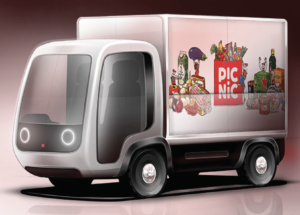Picnic is an online supermarket currently operational in the Netherlands and Germany. Groceries are ordered from an app and delivered to the consumers using a light electric last-mile delivery vehicle. This vehicle is currently used for densely populated residential adreas and works well enough to support the current number of Picnic deliveries.
However, the current last-mile delivery vehicle can not access all households. This is because its speed is limited to 50 km/h and can only carry a limited volume of cargo. To expand and reach new households, Picnic is looking for a new last-mile delivery vehicle. TU Delft (NL) student Rutger van Brouwershaven wrote his thesis about designing a new last-mile delivery vehicle for Picnic.
VDL, TNO, and Picnic
Having started a joint venture with VDL and TNO, Picnic is looking to design and build their very own last-mile delivery vehicle that is purpose-built for their needs. They are looking to become bigger, faster, and stronger on the roads. Increasing the vehicle speed to 80 km/h and carrying more cargo allows them to reach the households that are currently out of the geographic scope. Having a vehicle that can reach those extra households would significantly increase their customer base and consequently market share in the supermarket space.
With the opportunity to build a purpose-specific vehicle, they also have the opportunity to control the aesthetic of the vehicle. Picnic relies heavily on their brand image and identity as a means of differentiation from their competitors. Therefore translating their brand assets to the vehicle will give them a stronger brand presence in the consumer environment. Having identified the raison d’etre of the vehicle, reaching new households in less densely populated areas, research was carried out to find different design cues and assets that could be leveraged in the exterior design of the new vehicle.
The new vehicle had to look quirky, friendly, and electric
Accompanying these terms was a design vision also derived through research and in talking to the relevant stakeholders. “Design a next-generation company icon, to remain a local hero”. Using this input, the sketch phase was conducted with a funnel approach. Creating a broad spectrum of different designs and options that were in accordance with the design vision and form language derived from the research. Through the method of elimination with the input from the different stakeholders, the sketch phase reached a point of maturity, which consequently yielded a final design that satisfied the requirements derived from the research and embodied the Picnic aesthetic while remaining functional for the runners.
This final design was thereafter iterated once more and presented using renders from a CAD model along with detailed renders of key features and elements of the design. That is the final phase of the project and the culmination of the efforts documented in the report by Rutger van Brouwershaven.
Picnic runner’s experience
Also, check out the study by Ben Collin about improving the Picnic Runner’s Experience by applying user experience to vehicle design. The aim of this thesis is to implement knowledge of a user’s experience into vehicle design. The target user, the Picnic Runner is researched thoroughly to find where the ePV design lacks positive user experience. Problems around the current vehicle were assessed within the research stage with consideration of known foreseen problems with the new design. The Runner’s perception of safety was a found issue and a design was a concept created to help them work safer. This project is concluded with a design proposal that is grounded via research and tested prototypes.
Source: TU Delft

